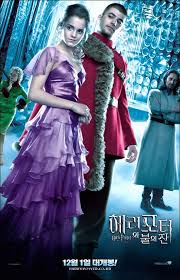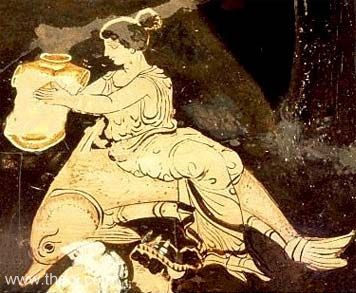
Well, as I’ve said many times, this is my favourite Harry Potter movie. There’s so much good stuff here – Eric Sykes! Doctor Who! Ginny getting plenty of screentime even when she has few lines! The random new people from Prisoner of Azkaban disappearing! Robert Pattinson! (much more attractive here than in Twilight, though rather too young for me even back then). Viktor Krum! Evil mermaids! Ralph Fiennes! Magic tents! A Christmas Ball! And a beautiful, sweeping score from Patrick Doyle.
This is also, of course, the pivotal book and the point at which the series starts to grow up. I think the moment where Harry weeps over Cedric’s body is quite possibly the best bit of acting Daniel Radcliffe has done for the series and the scene is played out with a fantastic intensity. The whole final section with the maze has a much more intense feel to it than Potter has had so far; I’m particularly impressed by Harry and Cedric’s desperate race for the trophy. The decision to put that slightly off, far too cheerful fanfare over Harry’s return was a stroke of evil genius and George from Drop the Dead Donkey will break your heart. Then, of course, there’s the graveyard scene, the creepiest, most terrifying and best scene from all the books and so far, from the movies as well (though Harry’s possession by Voldemort at the end of Order of the Phoenix gives it a run for its money). 'I want to see the light leave your eyes' gives me the chills every time.
The decision to make Beauxbatons and Durmstrang single sex schools works brilliantly, as it gives each school a really strong identity and makes for a very impressive entrance. It is a bit unfortunate that, since this means that the only female Champion came from a school with no boys, it does rather imply that boys make better Champions (and it doesn’t help that Fleur is, let’s face it, kinda wet and a bit rubbish). The selection of the Champions itself, though, includes another wonderfully done moment where Snape notices something’s wrong with the Goblet before anyone else.
Unfortunately for me, with the removal of the sphinx from the book (a very wise decision, and it would have thoroughly ruined the pacing during that crucial maze section) there’s very little particularly ancient or Classical in this movie, beyond the usual Latin spells (periculum is from the Latin for danger). So, um, I shouldn’t really be blogging it. But I’m nothing if not a completist and I didn’t want to leave out my favourite of the movies!
There is one ancient element in the film – the mermaids. Mermaids are not particularly big in Classical mythology, though they do crop up. Modern representations of the Sirens from the Odyssey sometimes picture them as mermaids, but in ancient art the Sirens are usually half woman, half bird and in the Odyssey, there’s nothing to suggest they aren’t simply women. The Assyrian goddess Atargatis, for various reasons, ended up half woman and half fish and Lucian still knew of this story in the second century AD. Aelian describes some sea monsters in the Indian Ocean that sometimes have the faces of women, with spines for hair – these sound the most similar to the film's freaky-looking mermaids than most. The Nereids, sea nymphs led by Thetis, were also sometimes depicted in mermaid form, though oddly enough it is rarely suggested that Achilles’ mother herself was half fish! The word ‘mermaid’ is Anglo-Saxon (‘sea-woman’) and I suspect that the modern view of mermaids, as
 attractive half-naked young ladies given to singing to sailors, is a later development (I don’t know how far back the identification of the Sirens with mermaids goes, but that may have had an effect on the development of mermaid folklore).
attractive half-naked young ladies given to singing to sailors, is a later development (I don’t know how far back the identification of the Sirens with mermaids goes, but that may have had an effect on the development of mermaid folklore).Nereid nymph riding dolphin, Apulian red-figure pelike. C5th B.C., J. Paul Getty Museum, Malibu. From www.theoi.com. This one has feet, but there's a mermaid-like look to the way she's sitting...
I love the interpretation of mermaids here. The friendly Narnian mermaids were based, in their fishy part, on dolphins, but these rather more ambiguous mermaids are based on sharks. They are not exactly evil creatures as far as the story is concerned, but they are pretty nasty and the really ugly look they’ve been given, complete with quite the attitude, always makes me think of them as the Evil Mermaids. Best of all is the contrast between these ‘real’ mermaids with the stained-glass window mermaid in the Prefects’ Bathroom (another nice touch, giving the usual moving portraits a fresh visual spin). The stained glass mermaid, the film suggests, is pure folklore; beautiful, elegant, obsessed with arranging her hair despite living under water. If mermaids really exist, it is implied, they are dangerous wild animals, not naked seductresses.
Dragons are pretty ancient as well of course, though these dragons owe more to Norse and Anglo-Saxon tradition (I would have loved to have seen the Chinese Fireball realized, but we don’t even see the miniature – it doesn’t sound like it has the good nature of ancient Eastern dragons, but maybe it looked like them?). The word is Greco-Roman (Greek drakon, Latin draco) but back then it meant any very big snake, and Greco-Roman mythology is much more interested in snakes, which crop up in all sorts of contexts, than in the sort of giant lizard that is usually pictured in the West when you hear the word ‘dragon’.

I’d better stop there, as I could go on about why I love Goblet of Fire all day. Though I could live without the mental images that always spring to mind when Cedric tells Harry about the bathroom and looks like he’s propositioning him…
Alas, poor Cedric.
I enjoyed this film, but they had to leave so much out. I wish they'd done 2 films and focused the first one on the World Cup. A lot of the motivations would be clearer. Moody is just brilliant, but I had problems with Barty Crouch, Sr. I identify him very strongly as Owen from The Vicar of Dibley and kept expecting him to make comments about having his arm up a sheep.
ReplyDeleteI read somewhere that the Spartans had a thing for mermaids in their art. I wish I could remember where. I don't think it was Cartledge. It might have been a footnote in my older Penguin edition of Pausanias, but I'm not sure. I always thought it was rather odd, though.
Ahhh, you make some very good points and I get why it's your favourite! ;o)
ReplyDeleteI did love the book, but even though you consider this to be important for Harry's growing up, I think Azkaban has a greater influence as it introduces him to true hatred when he first learns about Sirius Black and the supposed betrayal (and subsequent death) of his parents. That hatred... a very adult feeling.
I thought the Tournament very well done, but I was annoyed by it being the first movie that left out so much material. I mean, where's Percy?!?!?! (and I can't stand Percy)
My favourite moments I think have to do with the Ball, I'm a sucker for a chance to dress up and dance! ;o)
But yes, the Graveyard sequence... one of the best in all 6 movies to date! :o)
I was happy to see it leave out most of what went. Percy's subplot seems to have disappeared from the films as of the end of film 6, which is fine - it'll be very awkward if they suddenly introduce it at the end of Part 2 of Deathly Hallows, and I guess some film viewers may be wondering where Percy's gone, but I think we can live without it. And I hate the house elves subplot, so I was really, really pleased to see that go!
ReplyDeleteI thought Percy disappeared as of movie 4? I don't remember him at all in this one where he should have been replacing Crouch... I honestly don't think they'll bring him in for the 2nd half of Deathly Hallows, doesn't make any sense movie-wise.
ReplyDeleteYou must not have been happy to see the houselves return then! ;o)
He was with the Ministry, holding Harry in Dumbledore's Office, in OotP, but he wasn't named and didn't have any lines - maybe they just needed to fulfil his contract.
ReplyDeleteI can live with Dobby and Kreacher :) It's Harry and Ron's justifications of slavery that drive me up the wall!
ahhhh... I agree with you there, am totally behind Hermione on that one myself!
ReplyDeleteHi,
ReplyDeleteBack in undergrad I did an essay on classical myth in popular culture on an exam (which I never got back to see any comments, so I do not know how my prof thought of my argument)where I compared Harry's time in the graveyard with Odysseus' descent into the underworld. I found it quite interesting that if you pick out all the major shifts that occur to Odysseus and overlay them like a template to the graveyard scene, they really do match up. I can't remember off-hand all the details as this was ages ago, but I have always wondered if J.K. Rowling had done it on purpose - but have not had the chance to ask her, lol :)
What do you think?
I'm really enjoying our blog by the way!
Cheers Katie (@newmuseumkat)
Katie, that sounds fascinating! Will have to have another look at that scene.... Is Cedric Elpenor then? or is he the sacrificed sheep/goat/thing?
ReplyDeleteThis film is excellent and contains some of the best scenes and set-pieces I've seen, but all in all I have to say I prefer the preceding 'Prisoner of Azkaban' and 'Chamber of Secrets.' So much of the material from the book is shed, quite understandably, in order to streamline the experience, but it does give the unfortunate impression of being a variety of great scenes bolted together with very little else. You don't get much sense of the regular goings-on in Hogwarts and the Triwizard Tournament features much more prominently than it does in the novel, where, despite it's importance to the plot, it actually only accounts for a small amount of the book. This is where I feel the film falls flat. Nevertheless, it's possibly the most enjoyable and easiest to watch of all eight films, even if it is sadly lacking in substance (and mythological subtext.)
ReplyDelete